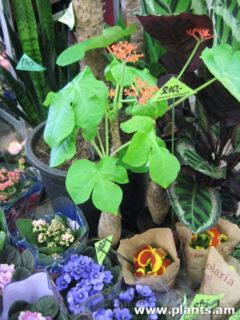Jatropha podagrica
| Jatropha podagrica {{{status}}} Fossil range: {{{fossil_range}}}
| ||||||||||||||||||||||||||||||||||||||||||||||||||||||||||||||||||
|---|---|---|---|---|---|---|---|---|---|---|---|---|---|---|---|---|---|---|---|---|---|---|---|---|---|---|---|---|---|---|---|---|---|---|---|---|---|---|---|---|---|---|---|---|---|---|---|---|---|---|---|---|---|---|---|---|---|---|---|---|---|---|---|---|---|---|
 | ||||||||||||||||||||||||||||||||||||||||||||||||||||||||||||||||||
| Plant Info | ||||||||||||||||||||||||||||||||||||||||||||||||||||||||||||||||||
| ||||||||||||||||||||||||||||||||||||||||||||||||||||||||||||||||||
| Scientific classification | ||||||||||||||||||||||||||||||||||||||||||||||||||||||||||||||||||
| ||||||||||||||||||||||||||||||||||||||||||||||||||||||||||||||||||
| [[{{{diversity_link}}}|Diversity]] | ||||||||||||||||||||||||||||||||||||||||||||||||||||||||||||||||||
| {{{diversity}}} | ||||||||||||||||||||||||||||||||||||||||||||||||||||||||||||||||||
| Binomial name | ||||||||||||||||||||||||||||||||||||||||||||||||||||||||||||||||||
| Jatropha podagrica Hook | ||||||||||||||||||||||||||||||||||||||||||||||||||||||||||||||||||
| Trinomial name | ||||||||||||||||||||||||||||||||||||||||||||||||||||||||||||||||||
| {{{trinomial}}} | ||||||||||||||||||||||||||||||||||||||||||||||||||||||||||||||||||
| Type Species | ||||||||||||||||||||||||||||||||||||||||||||||||||||||||||||||||||
| {{{type_species}}} | ||||||||||||||||||||||||||||||||||||||||||||||||||||||||||||||||||
| {{{subdivision_ranks}}} | ||||||||||||||||||||||||||||||||||||||||||||||||||||||||||||||||||
| [[Image:{{{range_map}}}|{{{range_map_width}}}|]] | ||||||||||||||||||||||||||||||||||||||||||||||||||||||||||||||||||
| Synonyms | ||||||||||||||||||||||||||||||||||||||||||||||||||||||||||||||||||
| {{{synonyms}}} |
Jatropha podagrica is a species of plant known by several English names, including Buddha belly plant, gout plant, tartogo, bottleplant shrub, and goutystalk nettlespurge.
Agronomic description
The plant can be propagated by seeds. Mature seeds can be planted in poly bags filled with a mixture of top soil, sand and well-decayed organic manure or compost. The plants can be planted in the field after four months. They can be planted in containers or can be directly planted in the field.
Potential in landscaping
It is an attractive ornamental plant. It can also be used as a specimen plant. The stem swollen into vasculum at the base is a special feature of the plant. Bright red flowers are also attractive and flowers can be seen throughout the year.
References
- De Silva N, 1998 A Selection of indigenous trees for traditional landscapes in Sri Lanka. Deveco Designers and publishers (Pvt) Ltd
- Dassanayake, M.D., Fosberg F.R. 1981 A Revised Hand book to Flora of Ceylon Vol ii. Smithsonin Institute and National Science foundation, Washington D.C. Amerind Publishing Co Pvt Ltd, New Dellhi
- Jayaweera D.M.A. 1981. Medicinal plants indigenous and exotic) used in. Ceylon, Part i, The National Science Council of Sri Lanka, Colombo 7.
- Jayaweera D.M.A. 1981. Medicinal plants indigenous and exotic) used in. Ceylon, Part 11', The National Science Council of Sri Lanka, Colombo 7.
- Jayaweera D.M.A. 1981 Medicinal plants indigenous and exotic) used in. Ceylon, Part ill, The National Science Council of Sri Lanka, Colombo 7.
- Jayaweera D.M.A. 1982. Medicinal plants indigenous and exotic) used in. Ceylon, Part iv, The National Science Council of Sri Lanka, Colombo 7.
- Martin E.C. Landscape design with plants. AVI Publishing Company Inc,west port connectiut
- Jayaweera D.M.A. 1992 Medicinal plants indigenous and exotic) used in. Ceylon, Part v, The National Science Council of Sri Lanka, Colombo 7.
- Rarnanayake L, De Silva G. 2002. Compendium of Medicinal plants. A Sri Lankan study Volume 2, Ayurvedic Department, Sri Lanka.
- I O.Ramanayake L, De Silva G. 2002. Compendium of Medicinal plants. A Sri Lankan study Volume 1,Ayurvedic Depal talent, Sri Lanka.
- Rao P.S. Venkaiah K. Padmaja R. 1999. Field Guide on Medicinal plants.Forest Department, Andra Pradesh, India.